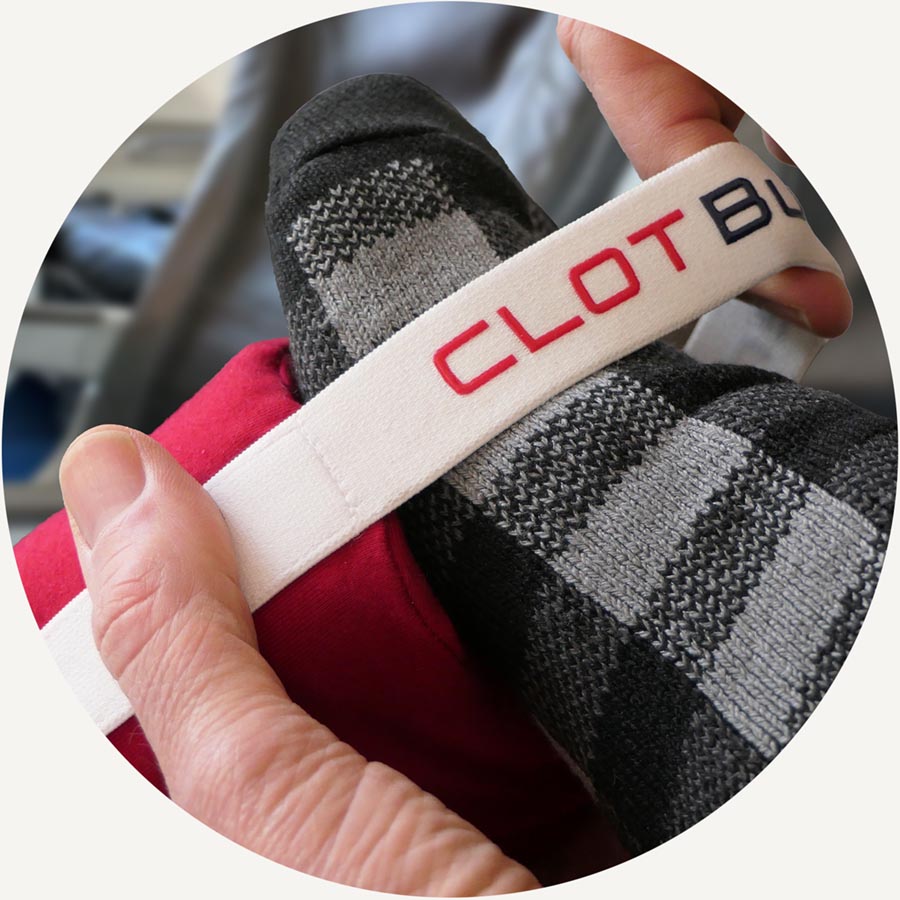CLOTBuster Clinical Study
CLOTBuster by Medinco Health
Background of the invention
In order to prevent the pooling of blood in the lower leg it is important to improve the blood flow from the deep vein plexus of the calf muscle.
Having identified the problem area and determined the remedy, it was decided that a form of compression device which could be comfortably pumped whilst in the seated position could be effective in stimulating the calf muscle pump.
A foot compression device was designed and clinically trialled. Volunteers were tested in a hospital environment using Doppler Ultrasound which is able to give an objective measure of blood flow velocity.
Flow velocity was observed within the popliteal vein (calf) of the volunteers in the seated position at rest as for an aircraft or coach journey, and with exercise of the foot as encouraged by using the foot pump.
The study was performed in the sitting position with doppler flows analysed by the same radiographer on the same day using the same Doppler Ultrasound machine. Popliteal doppler flows were measured in cms per second in the:
-
- Resting position;
- After one full compression to the floor with the foot pump comfortably under the mid sole of the foot and the heel on the floor;
- After compression with the heel on the floor and the foot drawn to a position of maximal dorsi-flexion without the pump;
- After compression to the floor with the toes on the floor and the heel raised to a point of maximal elevation above the floor.
Elevation of the toes or heel (depending on the exercise) was to a point of comfort rather than to a pre-determined height although the maximum elevation approximated 10cms.
Volunteers were encouraged to perform a normal compression without straining or over emphasising any particular movement.
Results demonstrated significant improvement in deep venous blood flow of the calf with simple pedal compression of the foot pump, compared to both resting venous flows and venous flows after basic floor exercise.
The mean increase in blood flow through the deep vein plexus of the calf as measured at the popliteal vein during exercise with the foot pump – compared to popliteal flow at rest was 1,207%. The mean increase in blood flow during exercise using the foot pump compared to basic exercises without the pump was 323%.

Frequently Asked Questions
What is the calf muscle pump?
The muscle pump in the calves ensures that the venous return back to the heart works properly. Every time the muscles contract, they squeeze the deep veins in the legs together and transport the blood further.
Why not use flight socks or stockings?
Compression stockings are the accepted product for minimising the risk of deep vein thrombosis. Compression stockings work by exerting the greatest degree of compression at the ankle, with the level of compression gradually decreasing up the garment. The pressure gradient ensures that blood flows upward toward the heart instead of refluxing downward to the foot or laterally into the superficial veins. The application of adequate compression reduces the diameter of major veins, which increases the velocity and volume of blood flow.
Problems and disadvantages of compression stockings:
- poorly fitted stockings can cause discomfort and at worst, pressure necrosis
- no muscle activity
- difficult to wear
- sweaty, expensive
- can’t apply easily over swollen part (hospital)
- different sizes
- may be problems in people with arterial disease
When used, graduated compression stockings need to be measured and fitted properly. People also need to be informed of the risks.
How do I use the CLOTBuster® In-Flight Passenger Foot Pump?
Place the device under the mid sole of your foot. Adjust the strap over the foot for comfort. With your heel on the floor, press down firmly on the device and release. For best results, use the CLOTBuster® In-Flight Passenger Foot Pump for 3 to 4 minutes every hour.
Is there anything else I can do to protect myself?
In Flight Exercises for Long-Haul Air Travel
These exercises should be repeated every hour on a flight when you are awake.
Neck roll:
While in your seat, with your shoulders and arms relaxed and hanging down, tilt your head to your left, hold for a few seconds, then slowly roll your head toward your back and hold for a few seconds, then slowly roll your head toward your right shoulder and hold for a few seconds, and then slowly roll your head toward your chest and hold for a few seconds. Repeat this exercise for a total of five times clockwise and then five times anticlockwise.
Shoulder roll:
While in your seat with your arms on the arm rests, move both shoulders in a circular motion from front to back five times and then repeat in the opposite direction.
Shoulder stretch:
While in your seat, put your left hand on your right shoulder. With your right hand, grasp your elbow and pull your left elbow toward your right side. Hold this position for 15 seconds and then switch arms and repeat the stretch with the opposite side. Repeat these stretches five times with each arm.
Knee-to-chest stretch
While in your seat, lean forward slightly and grab your knee just below the joint. Slowly pull your knee toward your chest and hold for 15 seconds. Repeat the stretch with your other knee. Repeat the cycle five times.
Ankle circles:
Raise your feet off the floor and rotate them in a circular motion five times clockwise and then five times counterclockwise.
